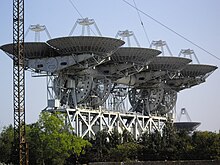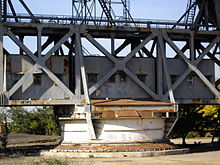Pluton (complex)
This article needs to be updated. (December 2016) |
You can help expand this article with text translated from the corresponding article in Russian. (May 2012) Click [show] for important translation instructions.
|
45°10′13.18″N 33°15′11.18″E / 45.1703278°N 33.2531056°E
 ADU-1000 South station transmitting array.[1] | |
| Location(s) | Republic of Crimea, Russia |
|---|---|
| Coordinates | 45°10′13″N 33°15′11″E / 45.170328°N 33.253106°E{{#coordinates:}}: cannot have more than one primary tag per page |
| Organization | Center for Deep Space Communications |
| Wavelength | radio 5, 8, 32, and 39 cm |
| Built | 1960 |
| Telescope style | array of Cassegrain reflectors |
| Diameter | consisted of eight (8) 16 metre dishes |
| Collecting area | ≈900 m² |
| Mounting | altitude/azimuth |
| Enclosure | none |
| | |


Pluton (at 1980ss – Pluton-M) is a system of deep space communications and planetary radar. It was built in Deep-Space Communication Center (real name "85 радиотехнический центр дальней связи с космическими объектами" - "Eighty-fifth Radiotechnical Center of Distance Communications with Space Objects") near Yevpatoria in 1960, and consists of at least three antennas. Three of them are of the ADU-1000 design, an assembly of eight reflector antennas, each with diameter of 16 metres. At the North station,[1] two receiving antennas were built, and a transmitter was constructed 8.5 kilometres away at the South station.[2]
Each receiving dish has a Cassegrain system with subreflectors mounted on quadrapods in front of the dishes.[3] The dishes were welded onto the hulls of two diesel submarines and laid down onto railway bridge trusses. The ADU-1000 antennas were mounted onto steerable frames constructed from battleship gun turrets and railway bridge trusses.[2]
The Pluton complex supported all the Soviet space programs until 1978, when the Yevpatoria RT-70 radio telescope was built, then the Pluton became a backup system for the RT-70. The Pluton complex was the world's highest capacity deep space communication system prior to Goldstone in 1966.
In 1961 it performed one of the world's first radar detection of the planet Venus. In June 1962 it performed the world's first successful radar detection of the planet Mercury. In February 1963 it performed successful radar detection of the planet Mars. In September–October 1963 it performed successful radar detection of the planet Jupiter.
On 19 and 24 November 1962, the words «MIR», «LENIN», and «SSSR» were sent in the direction of the star HD131336 in the constellation Libra. These message (The Morse Message (1962)[4]) are the first radio broadcasts for extraterrestrial civilizations in the history of mankind.[5]
Sometime around November 11, 2013, one (transmitter) of the three antennas was dismantled.[6]
In 1963 Bernard Lovell was the first Westerner who visited this site.[7] In 2009, Lovell spoke of a claimed assassination attempt in Deep-Space Communication Center during the Cold War where the Soviets allegedly tried to kill him with a lethal radiation dose.[8]
Missions
As Deep space communication system:
- Venera-1,-2,-3,-4,-5,-6.-7.-9,-10,-11,-12
- Mars-2,-3,-4,-5,-6,-7
- 1995–2000 – Interball-1
- November 16, 1996 – Mars 96.
As Planetary radar:
- 1961 April 18 and 26 – radiolocation of the planet Venus.[9] However the initial value of the AU deduced, and the time for the planet to rotate, were incorrect. These were later corrected to agree with other groups.
- June 1962, after increasing the sensitivity of the receiving equipment – the world's first radiolocation of the planet Mercury.
- October–November 1962 – second radar study of Venus.
- February 1963 – radiolocation of the planet Mars.
- September–October 1963 – radiolocation of the planet Jupiter.
Radioastronomy:
- April 1964 – study Crab Nebula
- 2004 – study coronal holes.
References
- ^ a b Sven Grahn. Yevpatoria - as the U.S. saw it in the 1960s
- ^ a b Don P. Mitchel. Soviet Telemetry Systems. Deep-Space Communication Centers.
- ^ Sven Grahn. ADU-1000 antennas at Yevpatoria.
- ^ An Awkward History of Our Space Transmissions
- ^ "MIR, LENIN, SSSR"
- ^ Последние дни АДУ-1000
- ^ New Scientist No343
- ^ "Sir Bernard Lovell claims Russians tried to kill him with radiation". The Telegraph. 22 May 2009.
- ^ Template:Cite article
